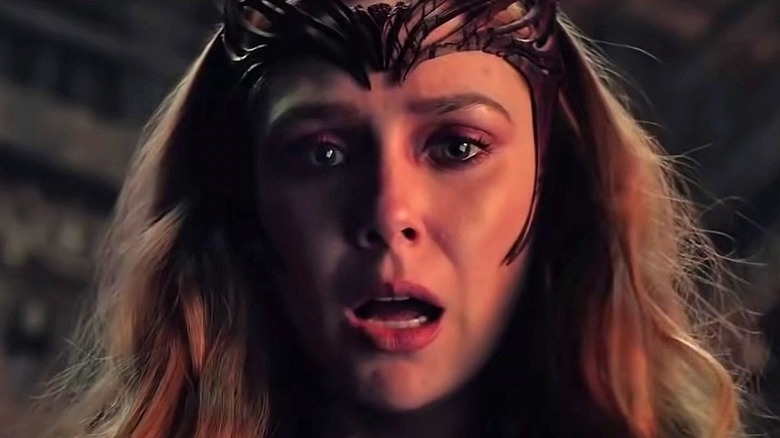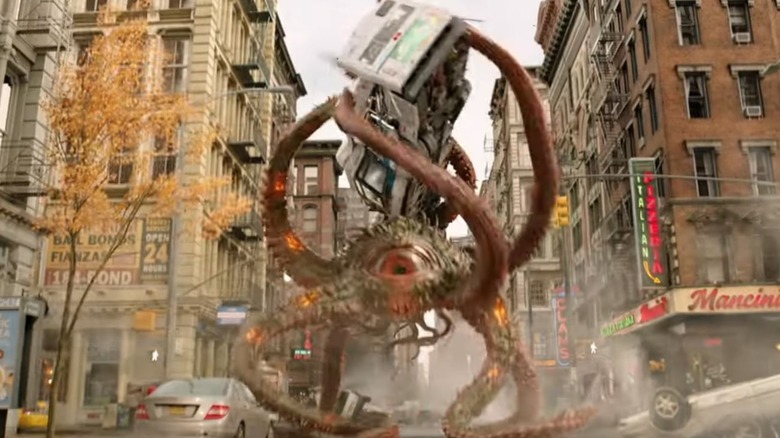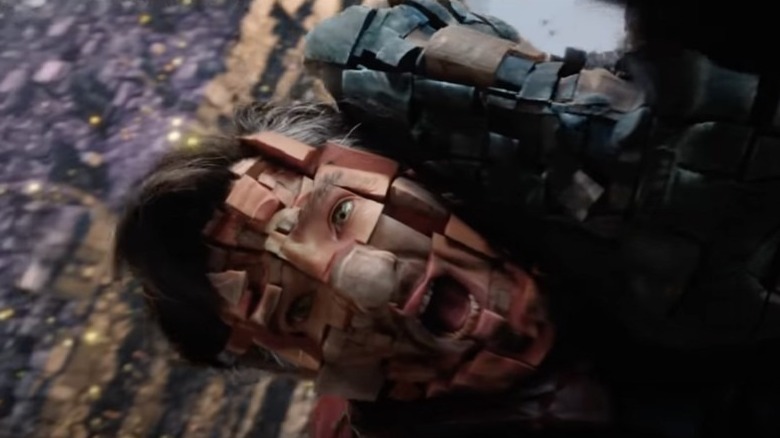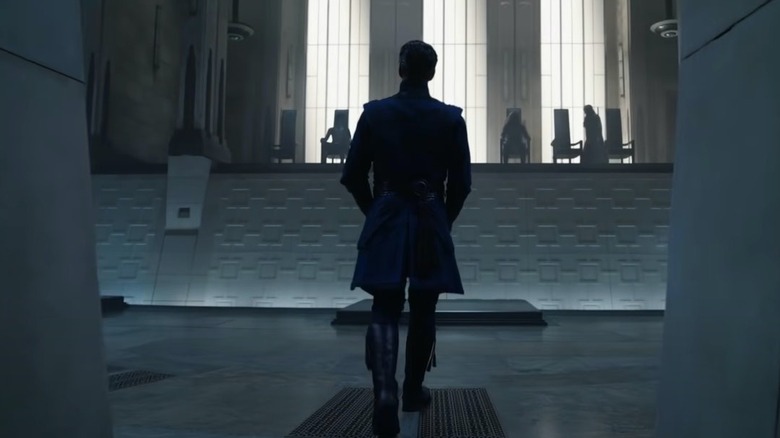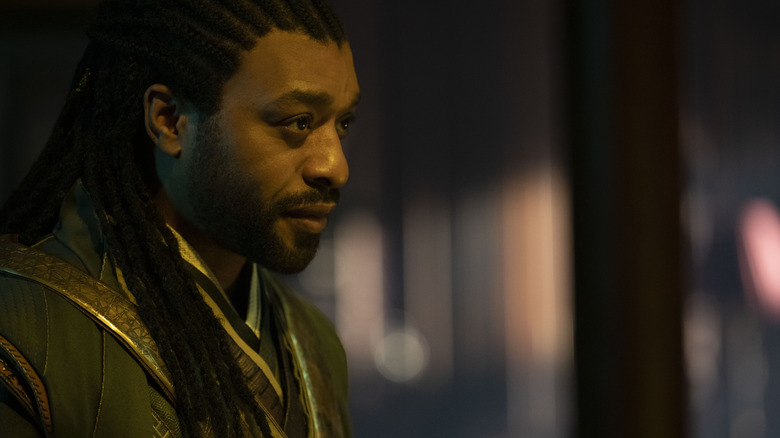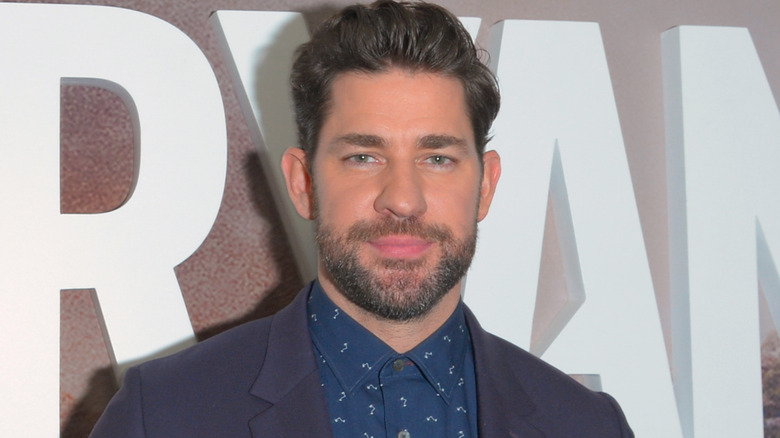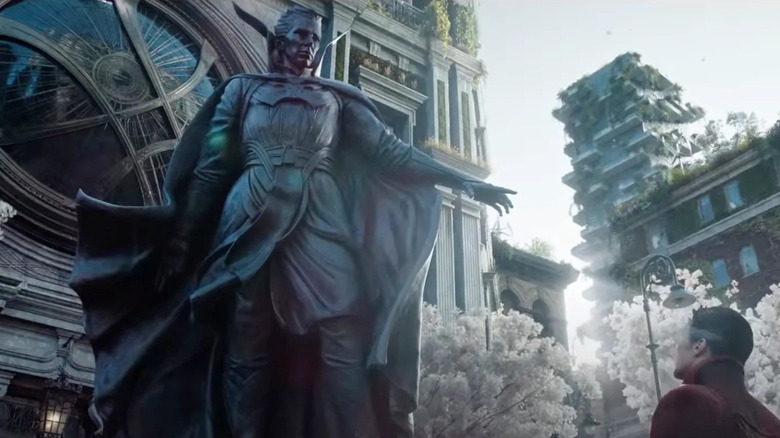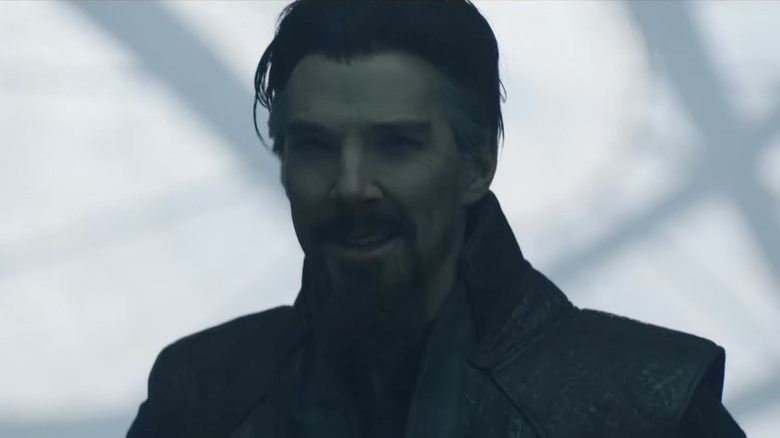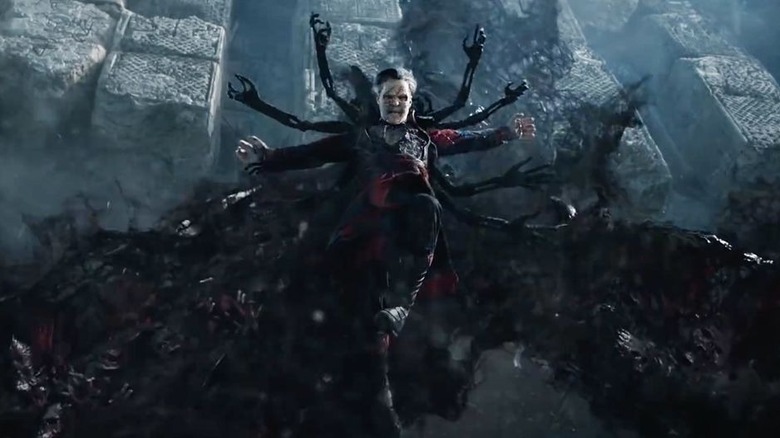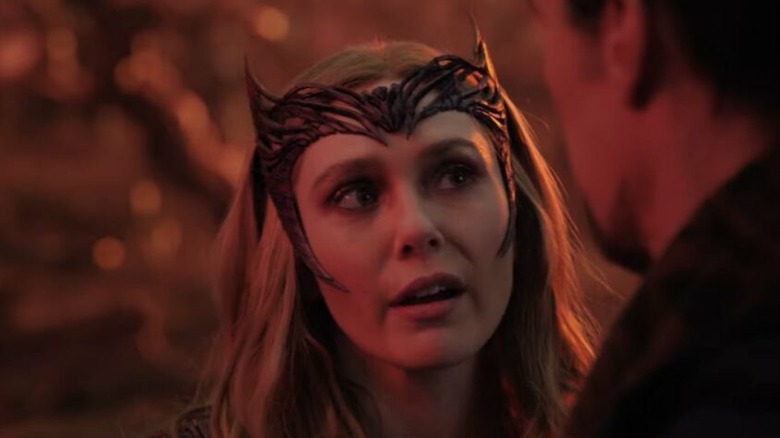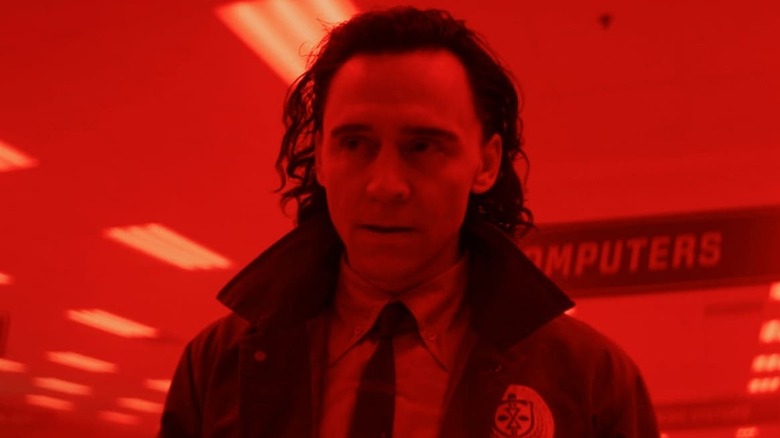Doctor Strange In The Multiverse Of Madness Moments That Upset Fans The Most
The reviews and fan reactions to "Doctor Strange in the Multiverse of Madness" are in, and for the most part, they're mixed to positive. Even those who are lukewarm on the film seem to agree about its strong points. It's easy to recognize famed horror-comedy director Sam Raimi's signature on this latest installment, which pushes the boundaries of PG-13 more than most MCU films ever have (more on that later). The brisk two-hour movie feels like one big chase scene, in a good way. And, despite a few plot holes, it's elevated by some excellent performances, especially that of Elizabeth Olsen as the Scarlet Witch.
However, "Doctor Strange in the Multiverse of Madness" hasn't lived up to every expectation fans had. For one thing, the scares and gore might be too much for some audiences, especially Marvel's youngest fans. More to the point, the film's trailers and other promotional materials made it look like "Multiverse of Madness" could be a big reset for the MCU, wrapping up the first half of Phase Four's overarching story and paving the way for the inclusion of the Fantastic Four and the X-Men. Instead, it plays more like a direct sequel to "WandaVision," even more so than as a follow-up to the first "Doctor Strange" (per the Los Angeles Times). These are the "Doctor Strange in the Multiverse of Madness" scenes that fans found most upsetting, disappointing, and hard to watch.
The Gargantos misdirect
A lot of the marketing for "Doctor Strange in the Multiverse of Madness" made it seem like a monster movie, with a particular one-eyed, eight-tentacled creature looking like the potential big bad. Some fans were already annoyed that Marvel referred to the character as Gargantos and not Shuma-Gorath. The latter is one of Doctor Strange's classic adversaries from the comics, while the former is an obscure sea creature of little narrative significance. Marvel couldn't call the beast Shuma-Gorath in the film (or sell any subsequent merchandise) because the studio doesn't own the rights to that name, so filmmakers essentially brought the Shuma-Gorath design to life as Gargantos (per ComicBook).
No matter what you call it, the monster doesn't turn out to be of much consequence to the story. It's pretty easily dispatched near the beginning of the film when Doctor Strange, using giant projections of hands, picks up a street lamp and impales it right in its giant peeper. The eyeball, with a disgusting amount of viscera still attached, splooshes to the street below in one of several moments that might be too much for some viewers to stomach. Mostly, fans who were looking forward to a creature-heavy feature were disappointed that Gargantos came and went so quickly, and some were surprised that Wanda was, in fact, the movie's true villain. On a related note, some viewers criticized the CGI in the Garagantos battle, though others praised the overall design.
Not enough universes
The movie is called "Doctor Strange in the Multiverse of Madness," but for some fans and critics, there weren't enough universes and there wasn't enough madness. We only see the multiverse depicted in its full, trippy glory in one sequence that was already heavily featured in the trailer. Doctor Strange and America Chavez travel through several universes — including a paint world and one full of dinosaurs — in a matter of seconds, but they spend most of the runtime in just a few. There's Earth-616, Earth-838, the universe that collapsed in on itself from an incursion where Sinister Strange resides, and the Gap Junction where the Book of Vishanti is kept safe, which is more like a space between realities. In a film that's ostensibly about infinite universes, that's a pretty modest number.
"Doctor Strange in the Multiverse of Madness" is weird, but it definitely could've been weirder, especially given all the other worlds alluded to in the film. Honestly, Earth-838 doesn't look much different than Earth-616, except for its proclivity for flowers. Marvel has been preparing its audiences for high-concept stories that play with the bounds of time and space for years now; even casual MCU fans surely could've handled more. The film also doesn't do much with the concept of the multiverse as it relates to other MCU stories, especially considering how frequently it's come up in the rest of Phase Four. Ultimately, even some fans who liked the film feel that it didn't live up to its title.
The Illuminati's arrogance
To those who knew what to look and listen for, the trailer for "Doctor Strange in the Multiverse of Madness" spilled the beans about both the Illuminati and Professor X's place among them. Nevertheless, fans still gleefully hypothesized as to who besides Charles Xavier might be seated in those chairs. Thanks to the film's title, many correctly assumed it was some other universe's version of the secret superhero society. What many (especially non-comics readers) didn't guess was that Earth-838's supposedly wise council, created and appointed by their own Doctor Strange, would be so condescending and short-sighted about the threat Wanda posed.
In addition to Professor X, the Illuminati consists of Karl Mordo, Black Bolt, Captain Carter, Reed Richards, and Maria Rambeau's Captain Marvel. When America Chavez and Doctor Strange 616 burst into their universe and start looking for the Sanctum, Mordo feigns surprise and delight before taking them prisoner. Richards gets Strange up to speed about how the Illuminati defeated their Thanos, then delivers the bad news that they've decided that he — meaning every Strange variant — is the most dangerous being in the multiverse. Their concern isn't unfounded; 838's Strange used the Darkhold to dreamwalk and killed a trillion people in an incursion.
The Illuminati have no doubt they can handle Wanda, who they quickly dismiss. Their righteous smugness and failure to listen (which is admittedly on brand) taint their character development, and it also makes what comes next frustratingly predictable.
The Illuminati's deaths
Anyone who hoped to see more than a few minutes of the Illuminati in "Doctor Strange in the Multiverse of Madness" will have those hopes viciously dashed once the Scarlet Witch arrives. Reed Richards — who is supposed to be the smartest man alive — overconfidently stands up to her and stupidly gives away their secret weapon. He says that Black Bolt could destroy her with a single whisper from his mouth, which is all the information Wanda needs to destroy them.
Black Bolt's death is probably the most gruesome in a movie that contains more than a handful of brutal and controversial kills. Wanda erases his mouth from his face, which panics him into imploding his own brain. She then turns Reed into spaghetti, cuts Captain Carter in half with her own shield, and snaps Professor Xavier's neck with her mind. Even if you don't mind seeing these characters bite the dust so easily, their deaths are unusually disturbing by the standards of the MCU. For some fans, though, it's not the violence that's the problem, but rather the immediacy with which the Illuminati are dispatched — a decision that makes their inclusion in the plot feel more like surface-level fan service.
John Krasinski as Reed Richards
John Krasinski's short stint as Reed Richards seems to have simultaneously thrilled and upset everyone on the internet. Fans of the actor have been lobbying for him to play the MCU's version of the character for years. Krasinski himself has repeatedly expressed interest in joining the MCU, particularly as Reed Richards. So when the "Office" alum shows up as Mr. Fantastic in "Doctor Strange in the Multiverse of Madness," it's a pretty big moment.
However, many of the same fans who were so excited to see Krasinski in the role weren't so happy when, only moments after his first appearance, Wanda rips him to shreds with her Chaos Magic. Some have taken solace in the fact that 838 is only one reality in an infinite multiverse, which means that Krasinski could (and likely will) reprise the role in the MCU's upcoming "Fantastic Four" film. Some of the actor's fans are even pushing for him to direct the movie. At this point, however, few official announcements regarding "Fantastic Four" have been made.
Of course, Krasinski isn't everyone's choice to play Reed Richards. Some fans just disagree that he's a good fit for the part, while others are put off by the role that fan-casting seems to have played in his selection. For them, Mr. Fantastic's violent comeuppance was satisfying, and it gives fans who'd prefer to see someone else in the role a little bit of hope, at least until more news breaks.
The Earth-616 reference
Some audiences have taken issue with what, to them, seems like a major continuity problem created by "Doctor Strange in the Multiverse of Madness." When Strange is brought before the Illuminati, he learns that they, not the Avengers, are the mightiest heroes of their universe, and that they have much more working knowledge of the multiverse than those in his home reality, which they refer to as Earth-616. Marvel Studios surely intended for this numerical designation to be an homage to the Marvel comics, where the primary universe is also called Earth-616. The MCU is known to pull story elements and shot compositions straight from the pages of the comics, but a lot of what happens in the films isn't remotely the same as the source material. In fact, the comics have previously referred to the main MCU timeline as Earth-199999. As such, the MCU's use of the 616 number has angered some fans and confused others.
There's also an additional continuity problem stemming from "Spider-Man: Far from Home." In that film, Mysterio tells Peter Parker about the multiverse and calls the Avengers' reality "Dimension 616," claiming that he himself is from "Earth-833." This complicates things for a few reasons. First, Mysterio's story of being from a different universe is a complete lie. Second, why would Mysterio and the Illuminati — people in completely different dimensions who've never met — both choose 616 as the designator for the main MCU timeline? On top of all that, Marvel seems hesitant to draw concrete distinctions between words like "dimension," "universe," and "reality," all of which are used in different ways but also seemingly interchangeably throughout the MCU.
The music fight
Marvel Studios has seemingly been more willing to give their directors aesthetic ownership over their individual films of late. Taika Waititi's unexpectedly irreverent "Thor: Ragnarok" is a great example of that trend. On the whole, this is a positive development for the franchise, but it's led to MCU movies varying wildly in tone. Fans have mostly been pleased with how much of director Sam Raimi's unique style made it into "Doctor Strange in the Multiverse of Madness," but there are some jolting tonal shifts within the movie, and some of them have proved quite divisive among audiences.
One such moment comes when Wanda reveals herself to be the villain. The film's horror influence becomes strikingly apparent as she crawls through reflective surfaces, contorts her body in impossible ways, and chases Doctor Strange and America through dark tunnels while covered in blood. The climax involving Zombie Strange is also a grotesque (and kind of funny) departure for the MCU, which is unmistakeably Raimi. But the fight scene that comes right before it, in which Doctor Strange fights Sinister Strange with a physical manifestation of the sound of music, is a tone shift within a tone shift that has divided some fans.
The director has always had a proclivity for mixing gore with absurdity, and some of his fans thoroughly enjoyed the imaginative music battle. However, others thought it was out of place and goofy to the point of making them cringe. This one's a matter of taste, so your mileage may vary.
The Souls of the Damned
When the trailer footage for "Doctor Strange in the Multiverse of Madness" included shots of Zombie Strange, many fans assumed he'd be a nefarious presence that Doctor Strange would have to face off against. So when Zombie Strange ends up fighting on the side of good instead — a magical puppet of the main Doctor Strange – it's a surprising and refreshing twist. However, the plot mechanics that make Zombie Strange possible have caused some division.
When Doctor Strange figures out what he has to do to defeat Wanda, he tasks Earth-838's Christine (who is admittedly more involved in superhero affairs than Earth-616's Christine) with protecting his body. While his consciousness is in the reanimated corpse, she has to defend his physical form against the Souls of the Damned, who rise in objection to the sorcerer possessing a dead body. Poor Christine gets little time to prepare and no instruction on exactly how to fight them off, which some fans felt amounted to shoddy writing.
The scene does give Raimi an opportunity to sample from his previous work in films like "Army of Darkness" (the hand punching out of the grave) and "Drag Me to Hell" (Christine blasting the Souls of the Damned), but audiences who haven't seen those movies won't benefit from the references. The result is a sequence that can be wildly entertaining, but also more than a little confusing.
Redemption for Doctor Strange but not for Wanda
In one of the best exchanges in "Doctor Strange in the Multiverse of Madness," Wanda calmly argues that it doesn't seem fair that both she and Strange have broken the rules in the past, yet he gets to remain a hero while she's painted as the villain. The Scarlet Witch goes on to do awful, unforgivable things, but at least at this moment in time, she has a point.
Though Elizabeth Olsen turns in one of the MCU's strongest performances — she nails both the nuanced, intimate moments and the big evil swings — many fans were surprised and upset by the fact that, in the end, Wanda isn't redeemed, while Strange is. The double standard is even more apparent once we learn that Sinister Strange also used the Darkhold to look for universes in which he ended up with Christine. Granted, Sinister Strange is clearly painted as a villain, and Wanda does eventually see reason. When her twins from Earth-838 appear so terrified of her, she chooses to destroy Mount Wundagore and all the Darkholds across the multiverse. Still, Wanda's hard turn from Avenger to power-hungry multiversal menace has rubbed many viewers the wrong way.
Specifically, some fans didn't appreciate the way Wanda's plotline seemed to play into toxic tropes about overly emotional women. The Scarlet Witch does alternate between hero and villain in the comics, but many who love the character think Elizabeth Olsen's empathetic portrayal is far better than the subpar, stereotypical writing to which she's long been bound.
No tie-in to Loki
Prior to the release of "Doctor Strange in the Multiverse of Madness," the multiverse was mentioned in the "Spider-Man" movies and alluded to at the end of "WandaVision." It's also the whole point of "Marvel's What If...?" and a major driver of "Loki" Season 1. Because Michael Waldren, who wrote "Loki," also wrote the script for "Multiverse of Madness," it seemed reasonable to expect some kind of tie-in between the two.
To be fair, "Loki" doesn't deal with the multiverse per se, but rather with the Sacred Timeline. Director Kate Herron has explained that the two concepts are intrinsically linked, but there aren't exactly the same (per Murphy's Multiverse). Still, the multiverse — in concept and name — clearly breaks open by the end of "Loki" Season 1, and the introduction of Jonathan Majors as He Who Remains (AKA Kang the Conqueror) foreshadows a wider multiverse plotline down the road. Kevin Feige has confimed that the events of the "Loki" Season 1 finale allow "Spider-Man: No Way Home" and "Multiverse of Madness" to happen (via Culture Crave).
With all that in mind, plenty of fans were crossing their fingers that we'd see Kang, Loki, Sylvie, or some other reference to the Disney+ series in "Doctor Strange 2." Alas, it wasn't to be. "Loki" didn't end up having a glorious purpose as far as "Multiverse of Madness" is concerned, which some savvy MCU theorists predicted well ahead of time.
